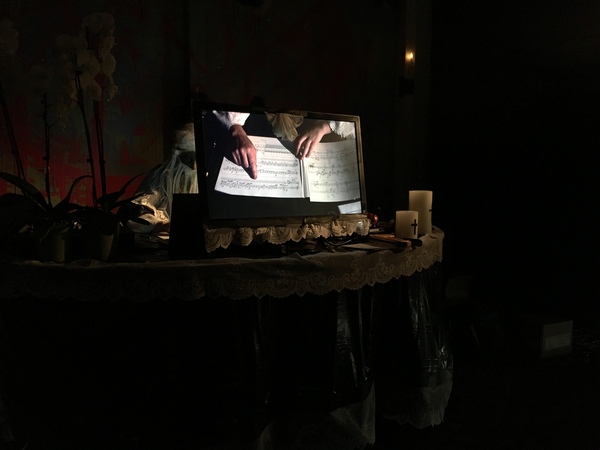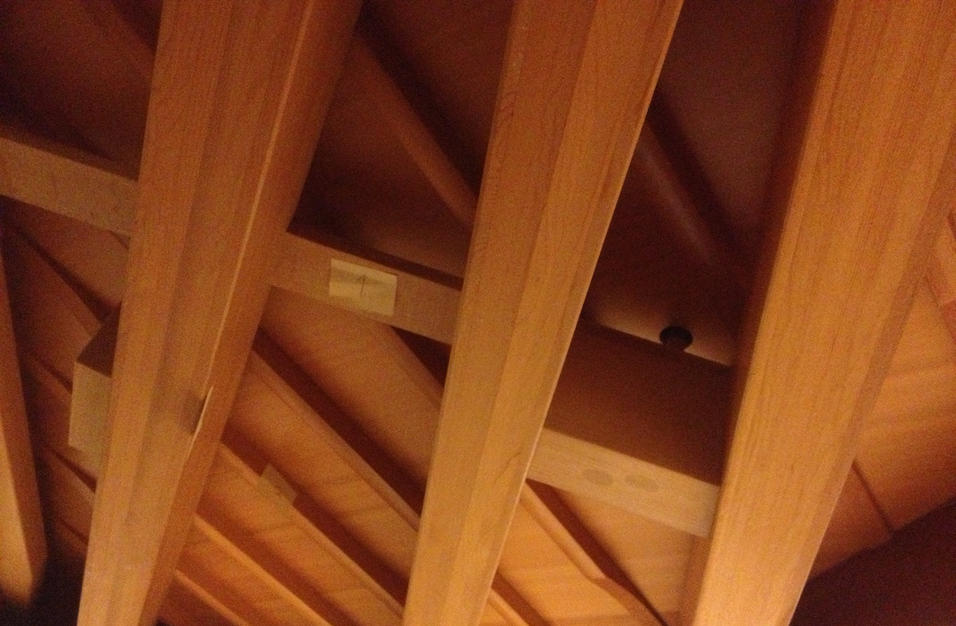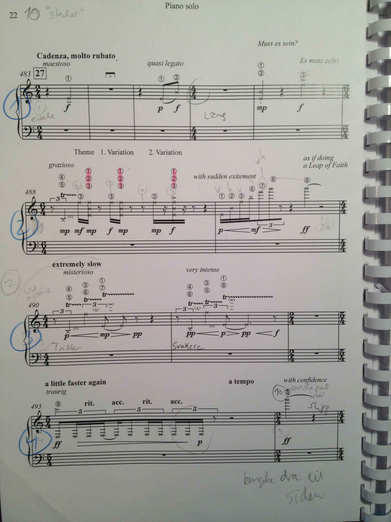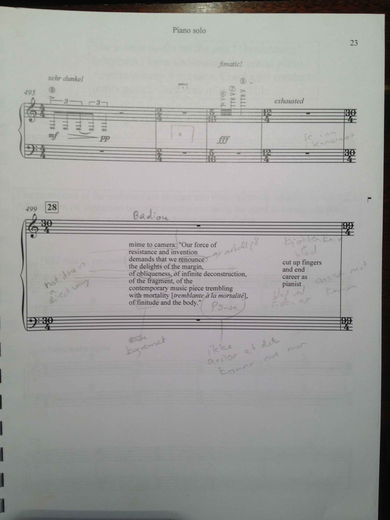Theory of the Subject
In well-known Trond Reinholdtsen style, the piano concerto Theory of the subject is a mixture of the concerto, performance art, disquisition on the theory of art and political propaganda, a work that regards itself from the outside while throwing various historical and literary references in all directions. In the Reinholdtsenian universe, most boundaries are fluid; they are transcended and pilloried. An impeccably dressed and traditionally ordered symphony orchestra melds with self-ironic explanations projected onto a screen, live video from a back room and videos of previous performances. (Halvorsrød, 2016a, my translation).
Trond Reinholdtsen’s works are some of the most intense artistic experiences and events I have ever taken part in, both as spectator and participant. I will never forget the performance of Narcissus at the Norwegian Opra, 1 a spectacle in Reinholdtsen’s own small apartment on Oslo’s east side, where I sat in the audience, open-mouthed, eventually soaked in both mud and Cava, as live rabbits and Reinholdtsen himself gave everything they had on a tiny stage just a few feet in front of me. It is not every day I’m mesmerised by art, but this was one such occasion. The richness and intensity of the work were overwhelming while the performance, at the same time, was deeply moving at a human level.
As a performer, I have participated in several works of Reinholdtsen with the asamisimasa ensemble, including performances at the Internationale Ferienkurse für Neue Musik Darmstadt in 2010 and Donaueschinger Musiktage in 2012. 2 I have done things in these works I would never usually have dreamed of doing as a pianist on a stage, such as decorating a cake with whipped cream and throwing it in the face of a colleague, or entering the stage with a bucket and mop to clean up mock faeces, or pretending to play ‘chamber music’ as five people pound and beat a singer’s body in time, holding her nose and pulling her cheeks while she extrudes a long-lasting tone.
Three months before the planned premiere of the piano concerto I took part in two works of Reinholdtsen at the festival ToPublic 3: Konserthuset and Ø (episode 9). 4 The essay Reinholdtsen wrote, which forms the third part of the project, can be found here. A video of the performances of Konserthuset and Ø (episode 9) was projected onto a big screen during the piano concerto Theory of the Subject and is therefore included in my presentation of the project The soloist in contemporary piano concerti, given that the works are connected. The challenges I faced as a performer in these works are far removed from anything I have previously encountered as a pianist. In what follows, I will, therefore, attempt to give an account of Konserthuset, Ø (episode 9) and Theory of the Subject since both projects differ from the other piano concerti in being more akin to ‘dramatizations’ than piano concerti.
I was an actor with a giant mask standing waist-deep in water in a small cove on an island outside Oslo, an actor moreover who knew nothing about the subject matter, an amateur. I tried to ‘give everything’ during the naval battle. Every time someone knocked me over I scratched my legs and arms on rocks on the sea floor. I threw myself at the boats, hearing the others breathing audibly and splashing around. How long were we supposed to keep fighting? When the intensity of the sound faded away, it was over. We all died on the waterfront where we kept laying motionless for 20 minutes on the beach, except Reinholdtsen’s character who was clumsily struggling with something resembling a raft which he began to paddle westward with his hands. The day was over. The chill of the water finally got in under my skin while a flying drone whirled above us filming the spectacle and broadcasting the scene from above onto a computer monitor placed on the grass for the viewing public.
Piano concerto
By contrast, in the piano concerto Theory of the Subject, I was myself again, as the soloist playing with the Oslo Philharmonic, Norway’s most prestigious orchestra. The piano concerto begins with beautiful melodic lines in the orchestra: the Yellow River Piano Concerto. 6 Via a series of PowerPoints projected onto a large screen behind the orchestra, Reinholdtsen sets out an argument in which he explains how the excerpt from the Yellow River Piano Concerto is actually our interpretation of John Cage’s Concerto for piano and ensemble. To adapt the interpretation for a critical contemporary music festival audience, and to subdue the Chinese work’s in-built communist propaganda, the horns and clarinets are transposed incorrectly, and the soloist removed.
The work continued then as a ‘normal’ piano concerto with music Reinholdtsen described from the screen as ‘mainstream contemporary music, with a hint of neo-classicism’. The music is not entirely devoid of programmatic elements; he declared: ‘it depicts, in a brutal but truthful way, the system or if you like, the status quo of today’s world.’ I was replaced as a soloist by the same player piano that was used in ‘the postmodernist quagmire’ in Ø (episode 9). The player piano is positioned centrally on the stage and played extremely fast, far outdoing anything a human soloist could achieve in terms of virtuosity.
Suddenly, a picture of me flashed onto the screen behind the orchestra. It was a live video from the soloist’s dressing room. I was sitting on a sofa reading Theory of the Subject by Alain Badiou. Then I got up and perform some caricatured gymnastic etudes on a piano without sound. The orchestra and the player piano continued playing their music, and the player piano again took off into insane finger-breaking somersaults.
I played cascades of clusters in ffff with and against the orchestra, followed by furious chromatic runs up and down the keyboard. My playing depicted the pianist’s struggle against the masses; I fought the orchestra’s blocks of sound and eventually had to ‘capitulate.' The orchestra drowned me out completely while the ghost on the screen behind the orchestra was shown being smeared with soil. Or it is excrement? After this section, I started playing musical quotations from the modernist repertoire I performed in Konserthuset. The orchestra soon began interjecting sounds similar to the release of air into the quotations, and a PowerPoint presentation announced that these instrumental sounds are ‘contemporary music clichés.' My quotations got shorter and shorter; the music dissipated, with only single notes from the piano remaining to accompany the sound of the wind machine.
A final section with powerful cluster chords was my last attempt to ‘be the soloist.' At the rear of the orchestra, one of the percussionists shattered a piano with a giant sledgehammer. The contest was lost. While my thighs quivered from the physical effort, I let myself very, very slowly slide off the piano stool onto the floor. I slithered under the piano on my back. Here I played my cadenza, consisting of playing screws, wood, and pedals. The cadenza is annotated down to the last detail.
On the big screen, a video was shown zooming into my brain where there was a jumble of books, sheet music, recordings and a pulverised piano. The film culminated in a simple painting of the Utopian bay on the island in the fjord. The piano concerto ended with conductor Cathrine Winnes sitting down among members of the orchestra while they all played soprano recorder mouthpieces. The instruction read’: ‘use telepathy for synchronisation.'
The process
My process with Theory of the subject lasted for about ten months and was also prepared through the preliminary projects Konserthuset and Ø (episode 9). In December 2015, Reinholdtsen showed me some small freehand sketches of how he imagined the ‘flight path’ of the piano concerto, including how he thought the live video could be used during my descent from the soloist’s dressing room to the concert hall and back again after playing a single note. I was to end up under the piano, in a kind of thicket. A few months later the sketches were more detailed and my assignments more accurate. I was invited in January to participate in Konserthuset and just before the summer to take part in Ø (episode 9).
The score of the piano concerto arrived late and was relatively sparse. Before the summer, I had received the music for the cluster section that I played after the documentary in the piano concerto, and Reinholdtsen wanted to know whether this part was playable at the specified tempo. I gave it a run-through and said yes, but it turned out afterwards that the music was supposed to be played in octaves in both directions, making it very challenging to play. The other parts arrived after the summer and, in the same manner as Concert Piece in three sections contained short historical references. Theory of the subject quoted directly from Mode de valeurs et d’intensités by Olivier Messiaen, Variations Op. 27 by Anton Webern and Klavierstück IX by Karlheinz Stockhausen. The quotes were repeated two or three times, each time shorter and more fragmented than the last. I had already played these works in their entirety in Konserthuset. Also, there was a longer, monotonal section that could be improvised freely or played as chromatic octave runs. The idea for this section was that it would be entirely overwhelmed by the orchestra, but it should nevertheless be obvious to the audience that I was ‘working very hard on a virtuoso passage.' Also, there were five or six gymnastic ‘études’ resembling more extreme versions of Alfred Cortot’s well-known études from his book Rational Principles of Piano Technique. These études were supposed to be performed and filmed in the soloist’s dressing room and projected onto a large screen behind the orchestra during the premiere.
As in Concert Piece in three sections and at the tips of my fingers / on the tip of my tongue, I had a cadenza in Theory of the subject as well. This time, however, the cadenza was not free. Every rhythmic detail was precisely noted. It was to be performed while lying on one’s back under the concert grand. Reinholdtsen and I found a room at the Norwegian Academy of Music with a couple of grand pianos identical to the one in the concert hall, and we plucked screws and tapped wood to find good sounds that could be used. We pasted ‘post-its’ on the various parts of the piano where the sounds would be produced.
I memorised the score and played the same screws and bolts that had been selected. Reinholdtsen’s body is long, and so are his arms. It was harder for me to reach the places indicated by the post-its in the accelerando movements indicated in the music. We made certain adjustments, however, taking my body into account. My personal stamp on the cadenza was not in the composition of new material, but in the timing and my physical ability to shape a musical form.
As described above, there was little material to play on the piano in this piano concerto, and most of it was repetitive and mechanical, with little variation. Where was my co-creative role in this work? My primary job in the composition was to be a kind of actor, but I felt I lacked both the knowledge and experience required to develop my stage personality. I was an amateur actor. I became, therefore, a recipient and executant of specific instructions, as in Ø (episode 9) where all the instructions were communicated via in-ear monitoring. I was not supposed to be Ellen Ugelvik, the pianist, but an ‘actor who played the character of Ellen Ugelvik, the pianist’ without making contact with the public in any way. I could neither smile nor communicate with the orchestra or the audience in any way; I was expected to look apathetic and not express anything physically. I felt my options were pretty limited. Since I was not familiar with the composition as a whole before the premiere and was unable to match Reinholdtsen’s knowledge of philosophy, politics and art history, I could not provide anything of value at the more elevated artistic plane of the composition either.
The co-creative role in Theory of the subject was different than in the other concerti. The challenge was to assume another role from that of a pianist, to be something else and to believe this other character had great value. I dared to take such a curious role (which consists of deconstructing the role of the soloist, myself) because I am used to performing pioneering repertoire. I am used to demolishing something in myself to make room to build something new, which at first does feel rather strange. The preliminary project Konserthuset was very demanding, because of the unusual duration of the performance playing exclusively complex music. The fact that what I was playing was being tracked closely by another pianist who sat reading the same sheet music was uncomfortable. Mark Knoop was observing my performance in detail with his finger on the score, and my actual reading of the score was projected to the audience as well. My relationship with a score is for me in a concert situation rather private, and this privacy feeds my feeling of room for artistic freedom in the concert situation. In Konserthuset I felt this freedom was disturbed.
All this was in addition to the sense of exhaustion from playing for so long in an unfamiliar and challenging setting. As the hours passed in this way, I crossed a limit, and the experience of playing became liberating rather than inhibiting; I accepted the role. In doing so I gained more freedom in the situation, I did not play a concert anymore, I was part of a performance.
In Theory of the subject, I filled my new hybrid role with the same kind of dedication as in a more traditional soloist role in which I play the piano. I tried to execute my assignments with the same type of concentration, focus, and energy as when I play the piano, with absolutely no ironic distance or other theatrical gesticulations. This piano concerto is not about music and the presentation of music, but about an overall idea or meta-focus. It was a principle I learned to accept.
Being the soloist in such a work demands lots of flexibility concerning the progressive mindset I am exploring. It pushed me in an another direction than the other works that are part of the project. I was struggling with the feeling of not participating in a co-creative way, but at the same time that was the premise that this concerto demanded; a soloist that accepted to step back and be able to perform in an active/passive way. It was challenging, but it was necessary to fill the role. This aspect also gave me the opportunity to broaden my horizon and to explore the multifaceted soloist role.
Toolkit:
a) Explore your role potential as a soloist and musician in every composition and cooperation, in old and new music, and enjoy the variety and shifts that apply to each situation. Be prepared for conflicts in your attempts to gain a versatile position. Exploration contains willingness to risk failure. The potential of the soloist role should be developed in close dialogue with the music and the context, not with the aim of changing the composition to something unrecognisable, but with the goal of pushing your freedom.
b) Introduce your students to a rich repertoire of music to give them the possibility to experience new aesthetics and different types of roles through playing. By testing out different kinds of approaches, the students are given a stronger foundation for reflecting upon their choices when building a professional career. Very, very few piano students will become one of the star soloists touring the world playing the canonical piano concerti. It is our responsibility to equip students with diverse tools to accomplish various tasks in the professional field and inspire them to create their way as performers. Our area will benefit from a greater variation of performances.
© Ellen Kristine Ugelvik | go to top
The role of the soloist | Diamond Dust | Concert piece in three sections | Practische Beispiele | at the tips of my fingers | Woven Fingerprints | Theory of the Subject
Konserthuset
Konserthuset was a small, makeshift building erected on the square in front of the old University buildings in central Oslo. The building served as a concert venue from 4 to 6 July 2016 and was later removed. From the outside, it looked like a homemade black box; inside, the performance space was fitted out like a crypt; very dark, the only illumination coming from mock candles, with smoke pumped in as a shroud. It was a mausoleum for modernist music. Standing on the small stage was a Steinway D grand of the highest quality. At Konserthuset, my colleague Mark Knoop and I played a four-hour long programme of modernist works for solo piano, all of them exceedingly demanding intellectually and physically. 5 The concert was repeated over a three-day period.
Ø (episode 9)
Ø (episode 9) was a performance in the extension of Konserthuset and started an hour after that concert in University Square was over for the day. In Konserthuset, Reinholdtsen takes the modernist canon to task and in the first part of (episode 9) Ø the players find themselves in a ‘postmodernist quagmire.' The venue was Reinholdtsen’s small apartment, in a warm room filled with soil, bark and large rubber frogs, in which masked characters (including Reinholdtsen himself) were reciting, singing, crying and wailing about the state of music.
A player piano (self-playing piano) played cascades of notes at the back of the room; towards the end of the ‘act’ I entered and played with and against this piano.
After this, the audience and the rest of us traveled by bus and boat to a small bay on an island in the Oslo Fjord (Hovedøya), where Reinholdtsen staged a ‘communist world revolution.' Characters such as Herzeleide, Tiresias, Dionysus, Thomas More, Stalin, Ho Chi Minh, Lenin, Pentheus and Che Guevara populated the island and were singing, reciting, eating and drinking while dreaming of their Utopia. I removed my pianist costume and put on a gigantic mask and ragged costume with a limp swim ring around my waist. I was playing Thomas More.
We had in-ear monitoring so we could hear Reinholdtsen’s pre-recorded instructions about what we were supposed to do. It was nearly impossible to see anything through the small holes I had for eyes. The heavy mask was always falling off; I staggered around gesticulating whenever More was speaking. I was pushed towards the audience, but I could not quite see where they were located because of the mask and I kept getting caught up in the costume of one of the other players and had to twist and turn to get free.
The revolutionary characters were eventually defeated by the capitalists in the form of synchronised swimmers who launched an attack on paradise. They arrived in boats from another bay. Fighting them in the water, we had wriggled out of our headphones, and I threw myself full tilt into the sea battle without knowing anything about where the others were and what my character was supposed to be doing. I was no longer Ellen Ugelvik, pianist.
The camera then switched to a tiny side room where the composer was tearing his hair out and talking about his crisis as a composer. By his side was his ‘pure artistic idea’ in the form of an actor fitted out as a ghost. They were talking to each other. I left the soloist’s dressing room, ran down the stairs with the camera in hot pursuit, entered the stage and played a single note, an e1, with the ring finger of both hands, the dynamics noted as pp.
The character of the music changed, the orchestra took up my note and continued in a calmer mood. I returned to the dressing room, sat down on the couch and stared into the camera as it moved closer and closer, the movement ending with a close up of my eye, and we were going back in time, to Konserthuset and Ø (episode 9).
In the concert hall, the lights were turned off, and the screen behind the orchestra showed a fifteen-minute documentary describing my personal ‘journey,' first as a pianist in Konserthuset and from there in a taxi to the apartment on Oslo’s east side. Then on to the postmodernist quagmire in Ø (episode 9) and the journey by boat to the island in the fjord, where I removed my pianist costume and became Thomas More. I was a member of the revolutionary group and was ‘liberated.' While the film progresses, I tiptoed onto the stage and sat ready at the piano waiting for the stage lights to come on.
There was a camera under the piano transmitting images to the big screen so the audience could see what I was doing. I also mimed mechanically to a voice reciting Alain Badiou at a delirious speed. ‘Our force of resistance and invention demands that we renounce the delights of the margin, of obliqueness, of infinite deconstruction, of the fragment, of the contemporary music trembling with mortality, of finitude and the body’ (Badiou, 2006).
I found a large knife and pretended to cut off two of my fingers with theatre blood spouting around. Then I mimed an aria Reinholdtsen recorded on Lenin’s famous words celebrating ‘Vernichtung/deconstruction.’
We alternated playing on stage, each of us performing one piece before changing places with the other in a sort of ‘ritual dance’ in middle of the room. While Knoop played, I sat at the back of the room carefully reading an extra edition of Knoop’s score. With my finger on the score, I tracked his progress at every moment, and this was broadcast to the audience via a computer monitor.
There were thus few real breaks in the concert. Knoop and I were dressed in identical costumes, black, ankle-length robes with lace collars and sleeves, long beards and wigs. Our faces were painted greenish-black: we looked like a couple of zombies, ancient humans or living corpses, one short and one tall. Our external identities as Mark Knoop and Ellen Ugelvik were obliterated. A friend who knew I was going to be playing asked one of the attendants when it would be my turn. I was already in full swing on the podium; she just had not recognised me. The beard frequently got in the way of my fingers; it was July and hot, and my sweat was dripping under my robe. Smoke was being pumped into the room at regular intervals, making it difficult to read the score at times. Spectators came and went, some gasped in amazement at what they saw, some whispered and talked, some laughed, a man lay down on a bench where he remained for several hours. Some returned on different days. Sometimes we played to an empty auditorium. Sounds from the outside mingled with the music through the thin walls; it is hard to stay concentrated.



